MacBook Air 15-inch vs. MacBook Air 13-inch: which to buy
The new MacBook Air 15 is likely to perform similarly to the smaller MacBook Pro 13, with comparable display quality. So the choice comes down entirely to size.
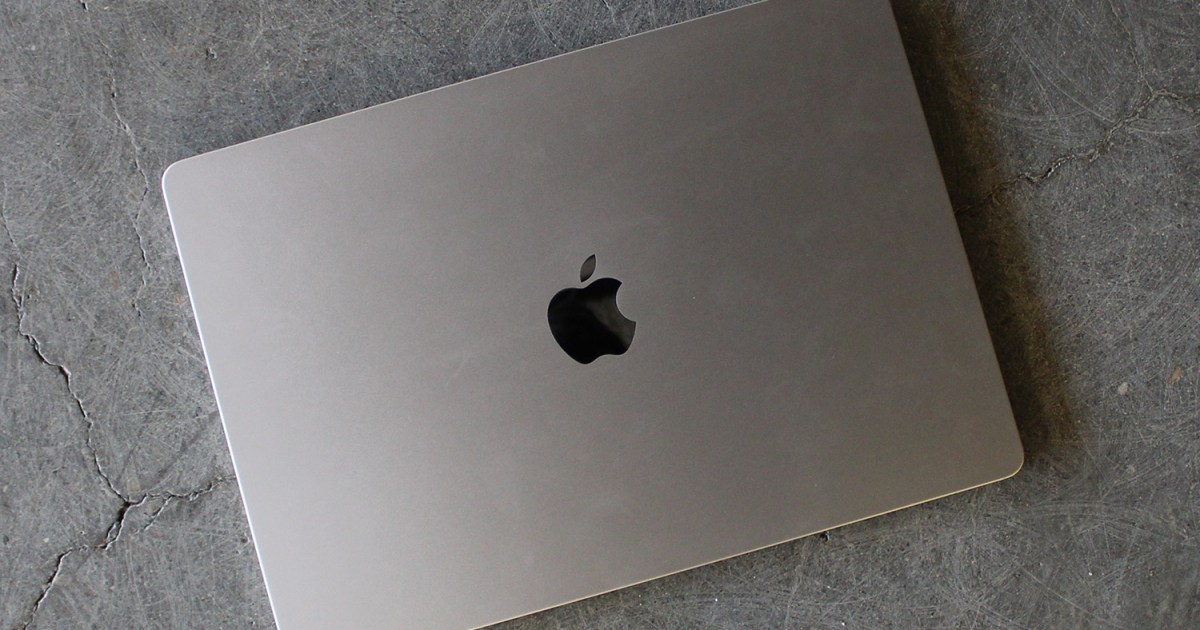
 Luke Larsen / Digital Trends
Luke Larsen / Digital TrendsFor the first time in a long time, there are now two size options for the MacBook Air. The difference in size between the 15-inch MacBook Air and 13-inch MacBook Air is dramatic, though you’ll find that these are otherwise very similar laptops.
So, which is better — or more importantly, which is right for you? We’ve reviewed both devices in-depth, so here’s everything you need to know about deciding between these two laptops.
Specs
| Apple MacBook Air 15 | Apple MacBook Air 13 | |
| Dimensions | 13.40 inches x 9.35 inches by 0.45 inches | 11.97 inches x 8.46 inches x 0.44 inches |
| Weight | 3.3 pounds | 2.7 pounds |
| Processor | Apple M2 (8-core) | Apple M2 (8-core) |
| Graphics | 10 GPU cores | 8 GPU cores
10 GPU cores |
| RAM | 8GB 16GB 24GB |
8GB 16GB 24GB |
| Display | 15.3-inch 16:10 Liquid Retina IPS 2880 x 1864 | 13.6-inch 16:10 Liquid Retina IPS 2560 x 1664 |
| Storage | 256GB SSD 512GB SSD 1TB SSD 2TB SSD |
256GB SSD 512GB SSD 1TB SSD 2TB SSD |
| Touch | No | No |
| Ports | 2 x USB-C with Thunderbolt 4 1 x 3.5mm audio jack |
2 x USB-C with Thunderbolt 4 1 x 3.5mm audio jack |
| Wireless | Wi-Fi 6 and Bluetooth 5.3 | Wi-Fi 6 and Bluetooth 5.3 |
| Webcam | 1080p | 1080p |
| Operating system | MacOS Monterey | MacOS Monterey |
| Battery | 66.5 watt-hour | 52.6 watt-hour |
| Price | $1,300+ | $1,100+ |
When similarly configured, Apple charges $100 extra for the extra screen size of the 15-inch MacBook Air over the 13-inch model. That’s not nothing, but it feels like a pretty fair price for the larger display.
There’s one caveat, though. Apple says a slightly slower and cheaper version of the M2 with just an 8-core GPU — but it’s only available on the 13-inch MacBook Air. That means it has a cheaper starting price of $1,100 compared to the 10-core GPU that comes standard in the 15-inch MacBook Air.
Both models can be configured up to 2TB of storage and 24GB of RAM, and Apple charges the same hefty prices for upgrades in both machines. You’ll want to choose carefully, too, since neither can be upgraded after the fact. If you want more of either memory or storage, you’ll need to opt for a 14 or 16-inch MacBook Pro.
Note that you can still buy the older MacBook Air M1, and you’ll save $200 at the entry-level by sticking with the older technology. Given the improvements in design and performance, though, we don’t consider it a legitimate competitor to the MacBook Air 15-inch, so we’ll leave it out of this comparison.
Design
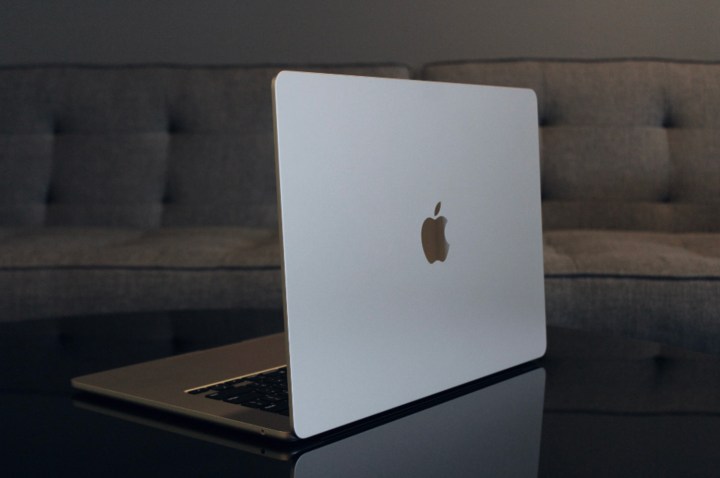 Luke Larsen / Digital Trends
Luke Larsen / Digital TrendsThe MacBook Air 15-inch looks exactly like the 13-inch model, only stretched out in width and depth. It’s almost as thin at 0.45 inches compared to 0.44 inches, making it the thinnest 15-inch laptop around. It adds about half a pound, at 3.3 pounds versus 2.7 pounds, meaning both are very light for their respective sizes. While the 15-inch MacBook Air is incredibly small for a 15-inch laptop, make no mistake: this is a big computer by comparison. The larger screen is the main draw of the laptop, and it’s certainly worth it if you can deal with the extra space this will take up on a coffee table or in your lap.
Both have the elegant, boxier look of the new MacBook line, with just the right angles and an aesthetic that doesn’t need any bling to make it incredibly attractive. Both laptops are available in Silver, Space Gray, Starlight, and Midnight color schemes. Both machines are also incredibly well-built, like all MacBooks, but due to their incredibly thin chassis, the lids do demonstrate some uncharacteristic bending.
Connectivity is shared as well, with just two Thunderbolt 4 ports and an audio jack. The MagSafe 3 power connector on both not only saves a Thunderbolt 4 port for connectivity but easily pops off if snagged. Both laptops also list Wi-Fi 6 in their specifications, which is a generation behind the faster Wi-Fi 6E, but both have the latest Bluetooth 5.3.
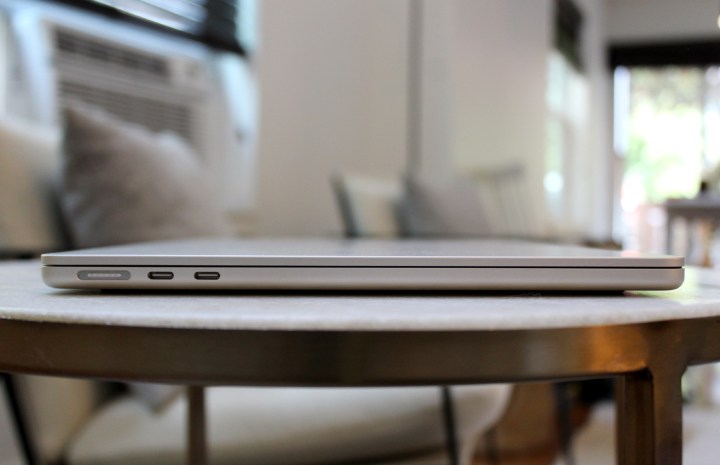
They both also share the same limitation in external display support. The M2 CPU only handles a single external monitor, at up to 6K at 60Hz. That’s a significant limitation compared to most Windows laptops, as well as the more powerful MacBook Pro 14, but it makes no difference in this comparison.
The 1080p webcam is an upgrade over earlier models, and both laptops use the same technologies to create a superior video image for videoconferencing. You’ll also find Touch ID embedded in the power button on both machines.
Performance
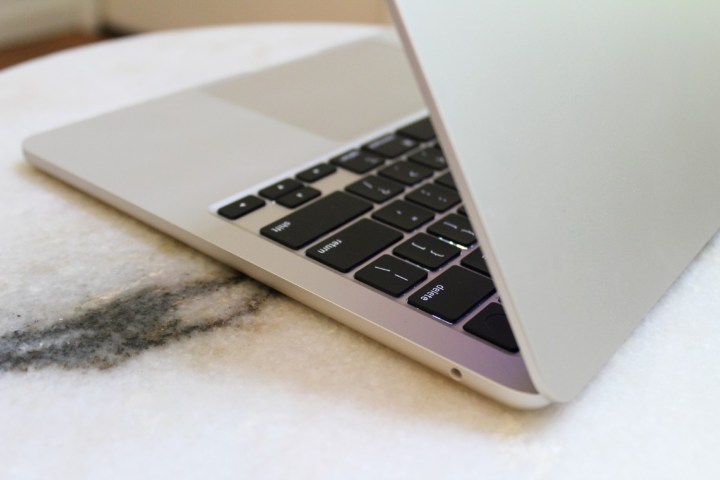
The MacBook Air 13 can be equipped with the slower eight-core CPU/eight-core GPU M2 processor, with the 8-core CPU/10-core GPU M2 as an upgrade option. The MacBook Air 15 uses only the latter. If you’re looking to save a couple of hundred bucks, that makes the starting configuration of the 13-inch MacBook Air an attractive offering, even if it has graphics horsepower under the hood.
According to our own testing, the two laptops perform identically when configured similarly. They’re both completely fanless, so while they do get a little warm during heavy loads, the laptops remain silent throughout.
The only real difference is in perception. We tend to think that larger laptops equate to more performance, but in this case, it’s simply not true. If you want a MacBook with some more oomph, you’re still better off buying the 14-inch or 16-inch MacBook Pro.
Display
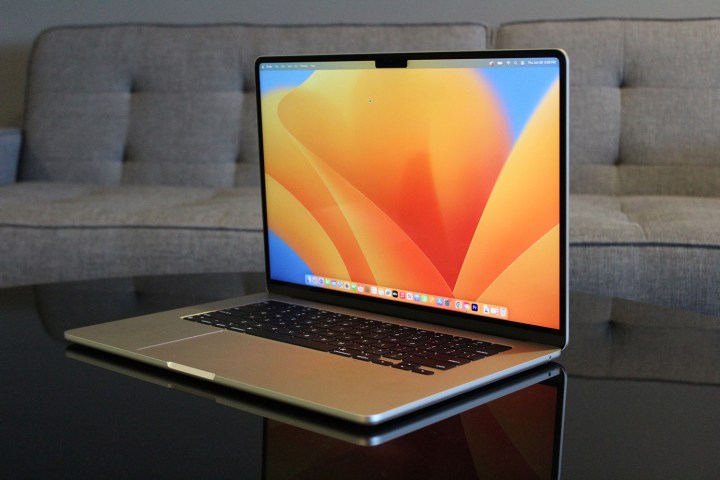 Luke Larsen / Digital Trends
Luke Larsen / Digital TrendsThe MacBook Air 13 and 15 both utilize the same Liquid Retina IPS technology, so they should provide similar performance. The MacBook Air 15’s panel is 15.3 inches at 2880 x 1864, and it provides similar sharpness to the MacBook Air 13’s 13.6-inch display at 2560 by 1664. The pixel density is identical to ensure that the larger screen isn’t just stretched out.
While these aren’t as great a display as the mini-LED panels on the MacBook Pro models, the MacBook Air 13 still provides excellent brightness, colors, and good contrast for any technology not called mini-LED or OLED. It’s a display that will please producers, creators, and media consumers alike, and we imagine the MacBook Air 15 will offer more of the same, only with more room for multitasking.
One area where the MacBook Air 15 holds an advantage is in its six-speaker setup with force-canceling woofers. They sound wonderful and are a meaningful upgrade over the four-speaker setup in the MacBook Air 13. Music sounds fuller, and there’s a noticeable enhancement to bass. We don’t know quite how Apple achieves this in a laptop so thin, but it’s one area where the 15-inch MacBook Air definitely wins out.
Portability
 Luke Larsen / Digital Trends
Luke Larsen / Digital TrendsAs mentioned previously, both laptops are almost equally thin, and they’re both very light. The MacBook Air 15 is larger in width and depth, of course, meaning it will take up more room in your backpack. But you’ll barely feel it.
In terms of battery life, both laptops will last an astounding 18 hours. That’s not just a claim from Apple, either — it’s actually how long you can use the devices away from an outlet. That’ll be reduced depending on what applications you’re running, but in general, you’ll find yourself getting through a day or two without needing to charge.
It all comes down to size

Apple made the 15-inch MacBook Air specifically for people looking for a larger screen. It’s not for more performance, despite what some people may assume given its size. If you’ve determined you don’t need the performance of the MacBook Pro, neither of these laptops will do you wrong. Apple is charging a fair price for the upgrade, especially since you’re getting both a larger screen and better speakers.
The 13-inch model is likely a better option for students and travelers, while most others will appreciate the extra screen real estate of the 15-inch size. If you’re still unsure, it’s worth seeing this in person and holding them in your hands — because the difference is significant.
Still, the $1,100 starting price of the MacBook Air remains attractive, and since Apple doesn’t offer the same M2 configuration on the 15-inch model, it’ll likely continue to be the go-to option.

 Astrong
Astrong 































